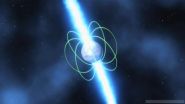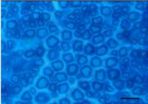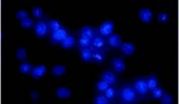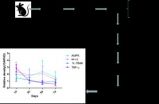(Press-News.org) An international team of astronomers has made a measurement of a distant neutron star that is one million times more precise than the previous world's best.
The researchers were able to use the interstellar medium, the 'empty' space between stars and galaxies that is made up of sparsely spread charged particles, as a giant lens to magnify and look closely at the radio wave emission from a small rotating neutron star.
This technique yielded the highest resolution measurement ever achieved, equivalent to being able to see the double-helix structure of our genes from the Moon!
"Compared to other objects in space, neutron stars are tiny – only tens of kilometres in diameter – so we need extremely high resolution to observe them and understand their physics," Dr Jean-Pierre Macquart from the Curtin University node of the International Centre for Radio Astronomy Research (ICRAR) in Perth said.
Dr Macquart, a member of the ARC Centre of Excellence for All-sky Astrophysics (CAASTRO), said neutron stars were particularly interesting objects to study, as some of them – called pulsars – gave off pulsed radio waves whose beams swept across telescopes at regular intervals.
"More than 45 years since astronomers discovered pulsars, we still don't understand the mechanism by which they emit radio wave pulses," he said.
The researchers found they could use the distortions of these pulse signals as they passed through the turbulent interstellar medium to reconstruct a close in view of the pulsar from thousands of individual sub-images of the pulsar.
"The best we could previously do was pointing a large number of radio telescopes across the world at the same pulsar, using the distance between the telescopes on Earth to get good resolution," Dr Macquart said.
The previous record using combined views from many telescopes was an angular resolution of 50 microarcseconds, but the team - led by Professor Ue-Li Pen of the Canadian Institute of Theoretical Astrophysics and a CAASTRO Partner Investigator - has now proven their 'interstellar lens' can get down to 50 picoarcseconds, or a million times more detail, resolving areas of less than 5km in the emission region.
"Our new method can take this technology to the next level and finally get to the bottom of some hotly debated theories about pulsar emission," Professor Pen said.
Testing their technique on pulsar B0834+06, the researchers found the neutron star's emission region was much smaller than previously assumed and possibly much closer to the star's surface – which might be the most crucial element in understanding the origin of the radio wave emission.
"What's more, this new technique also opens up the possibilities for precise distance measurements to pulsars that orbit a companion star and 'image' their extremely small orbits – which is ultimately a new and highly sensitive test of Einstein's theory of General Relativity," Professor Pen said.
The Australian Research Council has awarded Dr Jean-Pierre Macquart and Prof Ue-Li Pen $344,000 in research funding to continue to develop their technique and measure other pulsars.
INFORMATION:
Further Information
ICRAR is a joint venture between Curtin University and The University of Western Australia that receives funding from the State Government of Western Australia.
CAASTRO is a collaboration between Curtin University, The University of Western Australia, the University of Sydney, the Australian National University, the University of Melbourne, Swinburne University of Technology and the University of Queensland. It is funded under the Australian Research Council Centre of Excellence program and receives additional funding from the seven participating universities and the NSW State Government Science Leveraging Fund.
Original publication
Pen, Macquart, Deller, Brisken "50 picoarcsec astrometry of pulsar emission." in MNRAS Letters (May 2014).
Astronomers harness the galaxy's biggest telescope
Make most precise measurement of spinning star
2014-05-06
ELSE PRESS RELEASES FROM THIS DATE:
A novel transgenic mouse model of Chinese Charcot-Marie-Tooth disease type 2L
2014-05-06
Dr. Ruxu Zhang and colleagues from Third Xiangya Hospital, Central South University in China previously found that the K141N mutation in heat shock protein B8 (HSPB8) was responsible for Charcot-Marie-Tooth disease type 2L in a large Chinese family. Therefore, they generated a transgenic mouse model bearing the K141N mutation in the human HSPB8 gene, and to determine whether this K141NHSPB8 transgenic mouse model would manifest the clinical phenotype of Charcot-Marie-Tooth disease type 2L, and consequently be suitable for use in studies of disease pathogenesis. The K141NHSPB8 ...
Regulatory effects of glial cells on retinal synaptic plasticity
2014-05-06
Different types of retinal damage could induce plastic changes of retinal synapses, which might precede the serious damage of neuron soma. These morphological and functional changes to synapses after retinal injury could explain why many intervention measures protected neurons from death but failed to fully recover the damaged visual function. Therefore, it is necessary to investigate both the protection of synapses as well as protecting neurons from death. Dr. Lihong Zhou and co-workers from Central South University in China suggested that retinal glial cell activation ...
The Pael-R gene does not mediate the changes in rotenone-induced PD model cells
2014-05-06
Currently, the pathogenesis of Parkinson's disease is not entirely clear, but it has been generally considered to be the result of interactions among various genetic and environmental factors. Ting Zou and coworkers from Second Xiangya Hospital, Central South University in China previously found that Parkin mutation causes Parkin-associated endothelin receptor-like receptor (Pael-R) protein deposition, and the associated cytotoxicity leads to dopaminergic neuronal apoptosis. These researchers speculated that the Pael-R gene is possibly involved in the action of rotenone ...
AMPK and inflammatory mediators are involved in postoperative cognitive dysfunction
2014-05-06
Postoperative cognitive dysfunction is associated with neuronal apoptosis, which may result from post-surgery inflammation, the phosphorylation of tau protein and the accumulation of amyloid in aged people. 5′adenosine monophosphate-activated protein kinase (AMPK) can be involved in anti-inflammation, neuronal repair and anti-inflammation of the body through different downstream proteins and pathways. In addition, the activation of AMPK regulates tau protein phosphorylation and reduces amyloidogenesis in neurons. Yanlin Bi and co-workers from the Affiliated Qianfoshan ...
Danish social workers have become the moral agents of the state
2014-05-06
"We are turning the professional social workers into moral agents. This development recalls a time before the welfare state, when we had poor relief and when the extent to which the state could help you depended on your own dignity."
This is the assertion by Marie Østergaard Møller, who is associate professor at the Department of Political Science and Government, Aarhus University regarding the labour market policy that has been carried out in Denmark since the 1990s. More specifically, since 1994 the opportunities for citizens to get relief from the state have been reduced. ...
Hotspots of climate change impacts in Africa: Making sense of uncertainties
2014-05-06
Overlapping impacts of climate change such as drought or flooding, declining crop yields or ecosystem damages create hotspots of risk in specific parts of Africa. These are for the first time identified in a study now published by the Potsdam Institute for Climate Impact Research. The uncertainties in assessing the impacts do not necessarily hamper but can inform development strategies, according to the scientists. Likelihood and potential severity of impacts can be weighed to decide on suitable adaptation measures.
"We found three regions to be amongst those most at ...
Nanocellulose sponges to combat oil pollution
2014-05-06
All industrial nations need large volumes of oil which is normally delivered by ocean-going tankers or via inland waterways to its destination. The most environmentally-friendly way of cleaning up nature after an oil spill accident is to absorb and recover the floating film of oil. The Empa researchers Tanja Zimmermann and Philippe Tingaut, in collaboration with Gilles Sèbe from the University of Bordeaux, have now succeeded in developing a highly absorbent material which separates the oil film from the water and can then be easily recovered, "silylated" nanocellulose sponge. ...
Molecular switches age-related memory decline? Genetic variant protect against brain aging
2014-05-06
Philadelphia, PA, May 6, 2014 – Even among the healthiest individuals, memory and cognitive abilities decline with age. This aspect of normal aging can affect an individual's quality of life and capability to live independently but the rate of decline is variable across individuals. There are many factors that can influence this trajectory, but perhaps none more importantly than genetics.
Scientists are seeking to identify key molecular switches that control age-related memory impairment. When new molecules are identified as critical to the process of memory consolidation, ...
Yawning to cool the brain
2014-05-06
Common belief is that yawning helps to increase the oxygen supply. However, previous research has failed to show an association between yawning and blood oxygen levels. New research by a team of researchers led by Psychologist Andrew Gallup of SUNY College at Oneonta, USA now reveals that yawning cools the brain.
Sleep cycles, cortical arousal and stress are all associated with fluctuations in brain temperature, Yawning subsequently functions to keep the brain temperature balanced and in optimal homeostasis. According to this theory, yawning should also be easily manipulated ...
Exenatide has potential as a disease modifying agent in Parkinson's disease
2014-05-06
Amsterdam, NL, 5 May 2014 – A follow-up study of patients with Parkinson's disease (PD) who participated in an earlier "proof of concept" clinical trial using exenatide showed that improvements persisted twelve months after discontinuing exenatide therapy. These data provide strong encouragement for the further study of this drug in patients with PD, report researchers in the Journal of Parkinson's Disease.
Several recent discoveries have highlighted common cellular pathways that potentially relate neurodegenerative processes with abnormal mitochondrial function and abnormal ...
LAST 30 PRESS RELEASES:
Tea linked to stronger bones in older women, while coffee may pose risks
School feeding programs lead to modest but meaningful results
Researchers develop AI Tool to identify undiagnosed Alzheimer's cases while reducing disparities
Seaweed based carbon catalyst offers metal free solution for removing antibiotics from water
Simple organic additive supercharges UV treatment of “forever chemical” PFOA
£13m NHS bill for ‘mismanagement’ of menstrual bleeds
The Lancet Psychiatry: Slow tapering plus therapy most effective strategy for stopping antidepressants, finds major meta-analysis
Body image issues in adolescence linked to depression in adulthood
Child sexual exploitation and abuse online surges amid rapid tech change; new tool for preventing abuse unveiled for path forward
Dragon-slaying saints performed green-fingered medieval miracles, new study reveals
New research identifies shared genetic factors between addiction and educational attainment
Epilepsy can lead to earlier deaths in people with intellectual disabilities, study shows
Global study suggests the underlying problems of ECT patients are often ignored
Mapping ‘dark’ regions of the genome illuminates how cells respond to their environment
ECOG-ACRIN and Caris Life Sciences unveil first findings from a multi-year collaboration to advance AI-powered multimodal tools for breast cancer recurrence risk stratification
Satellite data helps UNM researchers map massive rupture of 2025 Myanmar earthquake
Twisting Spins: Florida State University researchers explore chemical boundaries to create new magnetic material
Mayo Clinic researchers find new hope for toughest myeloma through off-the-shelf immunotherapy
Cell-free DNA Could Detect Adverse Events from Immunotherapy
American College of Cardiology announces Fuster Prevention Forum
AAN issues new guideline for the management of functional seizures
Could GLP-1 drugs affect risk of epilepsy for people with diabetes?
New circoviruses discovered in pilot whales and orcas from the North Atlantic
Study finds increase in risk of binge drinking among 12th graders who use 2 or more cannabis products
New paper-based technology could transform cancer drug testing
Opioids: clarifying the concept of safe supply to save lives
New species of tiny pumpkin toadlet discovered in Brazil highlights need for conservation in the mountain forests of Serra do Quiriri
Reciprocity matters--people were more supportive of climate policies in their country if they believed other countries were making significant efforts themselves
Stanford Medicine study shows why mRNA-based COVID-19 vaccines can cause myocarditis
Biobanking opens new windows into human evolution
[Press-News.org] Astronomers harness the galaxy's biggest telescopeMake most precise measurement of spinning star






